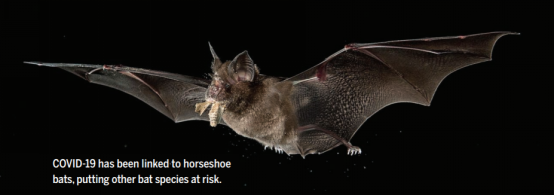赵华斌在《科学》发文呼吁全面认识蝙蝠
新闻网综合消息 Science(《科学》)杂志近日发表了生命科学学院赵华斌教授的短文(Letter),题目为“COVID-19 drives new threat to bats in China”(《新冠肺炎对中国蝙蝠产生了新的威胁》)。该文简要评价了新冠肺炎疫情对蝙蝠的负面影响,呼吁公众全面认识蝙蝠及其与人类的关系。

文中提到,在中国传统文化中,蝙蝠是福(蝠)气、长寿、吉祥、幸福(蝠)的象征。虽然全世界有1400多种蝙蝠,约占所有哺乳动物的25%,但是超过三分之一的蝙蝠物种受到了生存威胁,超过一半的蝙蝠物种的种群数量在下降。国际自然保护联盟(IUCN)认为,至少有80%的蝙蝠物种亟需加强保护。在我国,蝙蝠的种群数量与20年前相比下降超过50%,其中洞穴旅游开发、农药滥用和滥捕滥杀可能是最主要的三大原因。
随着COVID-19的传播,人们对蝙蝠非常恐慌。有居民报警要求相关部门把在家庭周边见到的越冬蝙蝠全部赶走。如此人为干扰冬眠蝙蝠会引起它们的不正常苏醒,导致蝙蝠的死亡,也可能导致其它病毒的传播。还有人将抓到的正在冬眠的蝙蝠,随意放到野外,而野外并不是该蝙蝠的自然栖息地,如此处理越冬蝙蝠会进一步威胁它们的生存。蝙蝠作为病毒携带者的坏名声导致有人建议杀死所有的蝙蝠。这种对蝙蝠负面影响的片面宣传,而不考虑蝙蝠对人类社会和生态系统健康的积极意义,将会导致大量无辜的蝙蝠被有意或无意地杀害。其实,所有的野生动物都可能携带病毒,是人类干扰加快了病原体从野生动物向人类的传播速度。

需要强调的是,蝙蝠具有极其重要的生态系统服务功能。食虫蝙蝠是非常经济的生物农药,仅在北美地区,它们通过减少作物损害和避免使用杀虫剂对农业的贡献就达到了225亿美元/年;访花和食果蝙蝠是很多生态、文化和经济重要植物的高效的传粉者和种子传播者。蝙蝠是优秀的科学研究对象:它们具有超常的寿命、强大的免疫功能、极低的患癌概率、关键的生态系统服务功能、超强的适应能力等,它们也是提高雷达、飞行器性能的主要仿生对象;科学家可以通过学习蝙蝠独特的生物学特征为人类服务。因此,帮助公众全面地认识蝙蝠,特别是它们对人类社会和生态系统的巨大贡献,对于蝙蝠的生存和保护是非常紧迫和至关重要的。
蝙蝠(包括其它野生动物)传播人畜共患病的最主要原因是:人类干扰。人类对森林的砍伐减少了蝙蝠的自然栖息地,迫使它们离开原来的生态位。蝙蝠失去了平常的觅食和行为模式,侵入人类居住地附近,直接或间接地将病毒传播给人类或家畜。我们呼吁,只要人类不干扰蝙蝠,不破坏蝙蝠的栖息地,蝙蝠携带的病毒可能就不会传染人类。相反,蝙蝠将给生态系统健康、人类的健康和长寿带来福音。保护蝙蝠多样性及其栖息地,不干扰蝙蝠的自然生活,就会减少蝙蝠病毒在人类中的传播,就是保护人类自己!
原文链接:
https://science.sciencemag.org/content/367/6485/1436.1